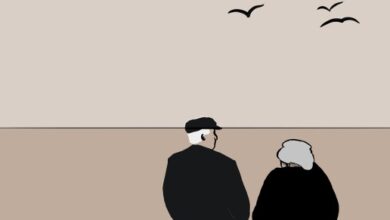“The Second Bakery Attack” is a short story written by the renowned Japanese author Haruki Murakami. Murakami is known for his unique blend of realism and surrealism, and this story is no exception. It showcases his distinct narrative style, characterized by introspective and contemplative protagonists, elements of magical realism, and exploration of themes such as identity, relationships, and the human psyche. In “The Second Bakery Attack”, Murakami delves into the complexities of a young married couple’s relationship. The story explores their shared hunger, both literal and metaphorical, and their quest to find satisfaction and fulfillment.
One recurring theme in Murakami’s works is the concept of alienation and isolation in modern society. This theme is also present in “The Second Bakery Attack”, as the husband and wife seem disconnected from each other, struggling to understand and communicate with one another despite being married. Murakami’s exploration of the character’s internal thoughts and emotions adds depth and complexity to their relationship, highlighting the challenges of intimacy and understanding in contemporary life.
The Second Bakery Attack | Summary
The story begins with the unnamed narrator, a young man who recently got married, waking up in the middle of the night with an intense craving for food. Despite searching their house, he and his wife find no food to satisfy their hunger. The husband reveals that during his youth, he and a friend attempted to rob a bakery but ended up with the food almost being given to them. When threatened, the baker, who was a “classical music freak”, promised them as much bread as they wanted if they sat and listened through an album of Wagner’s overtures. Intrigued by this story, the wife suggests that they rob a bakery themselves.
The couple acquires masks and a shotgun, and the wife demonstrates an uncanny knowledge of robbery techniques. However, unable to find any open bakeries at that time of the night, they change their target to an empty McDonald’s restaurant nearby.
The husband narrates his vivid daydreams, one of which involves him sitting on a boat above a dormant volcano in the middle of the ocean. He describes the horror of the dream, likening it to standing on a high steeple and looking into clear waters. However, he cannot understand why this dream instills fear in him.
The couple arrives at the McDonald’s, wearing their masks and carrying the shotgun. Inside, they encounter two employees who are preparing to close the restaurant, and a young couple, strangely asleep at a table. The wife takes charge of the situation, speaking confidently and assertively while the husband stands awkwardly with the shotgun. They demand thirty hamburgers, which the employees obediently prepare for them.
After obtaining the hamburgers, the couple leaves the restaurant and returns home. They eat a few hamburgers, and surprisingly, their hunger is completely satisfied. They decide to bring the rest of the hamburgers home and store them in the freezer. Following the robbery, the husband feels a sense of calm and acceptance in his marriage, ready to follow its natural course.
The Second Bakery Attack | Analysis
“The Second Bakery Attack” is a surreal and introspective short story by Haruki Murakami. The story follows a newly married couple who are plagued by an intense hunger that cannot be satisfied by conventional means. They embark on a peculiar quest to rob a bakery in order to appease their insatiable cravings.
One interpretation of the story suggests that the couple’s hunger symbolizes a deeper dissatisfaction or emptiness in their lives. It represents a longing for something more meaningful or fulfilling. Their decision to resort to a bakery attack reflects their desperation and the extreme measures they are willing to take to alleviate their existential hunger.
The story delves into the dynamics of the couple’s relationship. The wife emerges as a dominant and assertive figure, taking charge of the decision to rob the bakery and providing the means to carry out the act. This shift in power dynamics challenges traditional gender roles and portrays a sense of rebellion against societal expectations.
The act of robbing the bakery itself holds a symbolic significance. It represents a confrontation with their own desires and a willingness to challenge societal norms and rules. The couple’s actions can be seen as a metaphor for breaking free from the constraints of conformity and embracing their true desires and instincts.
Furthermore, the story blurs the boundaries between dreams and reality, emphasizing the fluidity of perception and the subjective nature of experience. Murakami often explores the concept of alternate realities and the interconnectedness of dreams and waking life in his works, and “The Second Bakery Attack” is no exception. The husband’s vivid daydreams with their surreal elements in the story highlight the fragility of our perceived reality and raise questions about the nature of existence. The dream-like imagery of the husband on a boat mid-sea, looking down through clear waters into the mouth of a volcano carries symbolic weight, suggesting the presence of suppressed emotions, anxieties, and fears within the husband’s psyche.
The marriage of the two characters does not seem to be a satisfying one throughout the story as is very evident in the lines :
“Whenever my wife expressed such an opinion (or thesis) back then, it reverberated in my ears with the authority of a revelation. Maybe that’s what happens with newlyweds, I don’t know”.
The husband describes his wife as “old-fashioned”, which seems more like a justification for their incompatibility, and a contrast against and proof of his submissive nature against her invigorating one. His attempts at humor go unheeded by her, and when he suggests that they go out to find a place to eat, his wife rejects this idea despite their hunger. It is also at this very juncture in the story, between the moment that she says this and he offers his response, that another vivid vision ensues in his mind, almost as if it were an unconsciously developed coping mechanism. The husband’s common recourse to daydreaming further reinforces his submissive attitude in response to his wife’s domineering one. At the end of the story, his dream ultimately dissolves, signifying a release of these pent-up emotions and a newfound sense of calm and acceptance.
However, what is termed the “curse” that has befallen the protagonist is somewhat debatable. Though at the end of the story, we find the curse lifted and the narrator contently “stretched out in the bottom of the boat and closed my eyes, waiting for the rising tide to carry me where I belonged”, one can interpret this curse as the passivity that he tells the story with. The incident of the robbery is described with a certain existential aloofness in spite of being told in first-person, as if the events were happening to the narrator, without his active involvement. This passivity is further made clear in the early lines of the story :
“I myself have adopted the position that, in fact, we never choose anything at all. Things happen. Or not.”
The momentary appearance of the volcano that unsettles him to the point of action is pushed back into absence once more, back to existential passivity at the end of the story.
Additionally, the lack of specificity regarding the characters’ names, the year of their marriage, and their backgrounds add to the overall surreal atmosphere of the story. By omitting these details, Murakami creates a sense of ambiguity and invites readers to focus on the symbolic and metaphorical aspects of the narrative rather than on specific individuals or circumstances.
Another interesting point to note is the young couple who sit soundly asleep at the table at McDonald’s. They do not stir in the least when the restaurant is robbed. The whole encounter in the story may be interpreted as a dream that this young couple has, who truly are the narrator and his wife.
Alternate to this interpretation, the sleeping couple in the story may also serve as a deliberate contrast to the main characters, particularly in terms of their peacefulness and contentment. Their ability to sleep undisturbed may be attributed to their youth, as they have not yet been burdened by the responsibilities that accompany marriage and adulthood. Importantly, the alignment of their heads suggests a shared perspective and mutual understanding. The description of their heads and strawberry-milk-shake cups aligned like an avant-garde sculpture conveys the idea that the couple’s satisfaction is seen by the husband as both artistically perfect and unconventional, far removed from his own experiences.
Furthermore, the absence of mention of food, with only milkshakes being referenced, implies that their ability to find contentment lies not in material possessions or physical nourishment, but in the company of each other. The husband sees their satisfaction as something extraordinary and unique, akin to avant-garde art, as it deviates significantly from his own personal experiences. This highlights the longing and yearning he feels to attain the same level of fulfillment and tranquility in his own relationship.
In the concluding moments of the story, when the wife finally falls asleep, the husband observes her peaceful state as “as soft and as light as a kitten”. This description carries irony, considering her active involvement in the armed robbery they had just carried out. However, it holds significance as it implies that the sense of contentment they sought through the bakery attack might be solely experienced by the wife. The fact that she is the only one sleeping suggests that the fulfillment they sought may not fully satiate the “special kind of hunger” that both partners initially felt at the beginning of the story.
Significantly, the narrator finds peace only when he is finally alone, coinciding with his wife falling asleep and the disappearance of the volcano. The once hyper-transparent water surface, which previously exposed underlying dangers, now reflects a serene and promising “blue sky” above. The previously threatening water now provides comfort, and the depiction of “little waves” portrays a life filled with gentle and subtle activities. Comparing the waves to “silk pajamas” evokes an image of luxurious laziness, suggesting that with the dissipation of his wife’s expectations, the narrator can return to his preferred state of leisurely drifting.
The story concludes with the narrator immersed in a daydream, symbolized by being “stretched out” as the shotgun mentioned earlier, and awaiting the “rising tide”. This ending can be interpreted in two ways. It may represent the narrator’s trust in the superior power of nature to guide him to his destined path, or it could signify a potentially ominous symbol of impending danger lurking beneath the surface.
Overall, the final scenes of the story convey a shift in the narrator’s perspective. With his wife’s expectations temporarily diffused, he embraces the tranquility and possibilities of life, symbolized by the serene water and the rising tide. However, the open-ended conclusion leaves room for interpretation, suggesting that there may still be underlying uncertainties and potential challenges that lie ahead.
The Second Bakery Attack | Themes
Marriage: The wife in “The Second Bakery Attack” displays a notable disconnect from her husband, often rejecting his suggestions and showing little interest in his conversation. Their contrasting personalities make it difficult to comprehend how they ended up married to each other. However, her curiosity about her husband is sparked when he inadvertently mentions the bakery attack from his past. Despite her traditional inclinations and disapproval of late-night dining, she becomes intrigued by his hidden and unpredictable side.
Exploration of power dynamics: Throughout their relationship, the wife has established a sense of control over her husband, evident in her dismissive attitude towards him and her belief in her superiority. Her comment about his work serves as a reminder of her perceived dominance. Furthermore, her adeptness and practiced efficiency during the second bakery attack indicate her ability to handle any situation that arises. The wife’s character highlights the power dynamics within their marriage, showcasing her control over her husband and her ability to adapt to various circumstances. Her interest in his hidden side and her self-assured demeanor contribute to the complexities of their relationship and the exploration of gender roles within the story.
The Second Bakery Attack | Character Sketch
The deliberate omission of the characters’ names in the story suggests a lack of true knowledge and understanding between the married couple. By leaving them unnamed, Murakami emphasizes the idea that despite their marital bond, there is a significant gap in their understanding of each other’s inner selves and desires.
The husband, or the narrator has a tendency to withdraw from stressful situations into his own thoughts, meaning that he becomes absorbed in himself and resolves nothing.
The wife, on the other hand, is portrayed as a strong and assertive figure within the story. The wife’s character undergoes a transformation throughout the course of the narrative. Initially, she appears as a simple and nice individual, but as the story progresses, her intrigue with the idea of robbing a bakery becomes more evident. She takes the lead in planning and executing the attack, providing the necessary tools and demonstrating expertise in the field. Her dominant nature and confidence contrast with her husband’s more passive and introspective demeanor.
The Second Bakery Attack | Literary Devices
The boat in the story symbolizes the husband, reflecting his inclination to drift aimlessly through life without a clear sense of direction. On the other hand, the undersea volcano represents his wife, who intrudes upon his personal space and presents him with expectations and demands. The use of the word “thrusting” conveys a sense of intimidation and fear that the wife imposes upon him. The husband remains uncertain about the proximity of the volcano to his boat, intensifying the terror he experiences in relation to his wife.
Murakami’s decision to employ a first-person narrative in “The Second Bakery Attack” is intriguing, as it presents the perspective of a character who is either unable or unwilling to provide a genuine account of his thoughts and emotions. The narrator is an unreliable narrator who fails to offer a transparent view of his inner world, much like he does with his wife. His character is intentionally kept ambiguous, and he only superficially delves into his feelings about his marriage, using recurring cinematic imagery.
The narrator’s consistently distant tone of uncertainty evokes frustration in the reader and effectively reflects the exasperation his wife would feel towards him. It is noteworthy to mention the use of flashbacks in the story, as it becomes apparent that what initially appears to be a somewhat happy ending does not truly conclude the narrative.
The opening sentence, “I’m still not sure I made the right choice when I told my wife about the bakery attack,” hints that the bakery attack has not successfully broken the curse or improved the couple’s marital dynamics. If it had been successful, one would expect the narrator to express certainty in having “made the right choice”.
In essence, Murakami’s narrative technique, utilizing an unreliable and detached narrator, contributes to the reader’s frustration and adds depth to the portrayal of the couple’s troubled relationship. The story’s opening line foreshadows an unresolved outcome, casting doubt on the effectiveness of the bakery attack in resolving their underlying issues.



